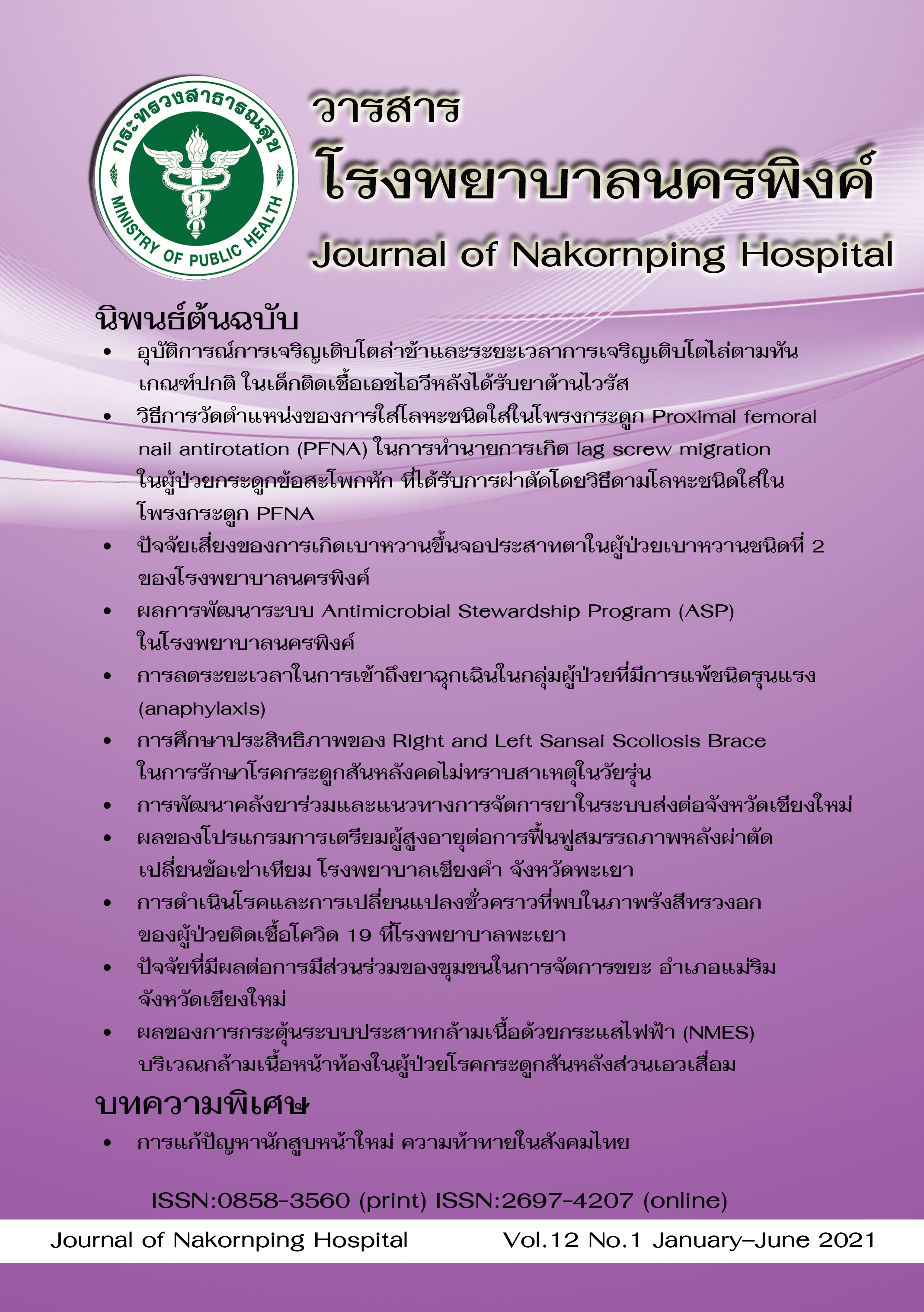การดำเนินโรคและการเปลี่ยนแปลงชั่วคราวที่พบในภาพรังสีทรวงอกของผู้ป่วยติดเชื้อโควิด 19 ที่โรงพยาบาลพะเยา
คำสำคัญ:
COVID-19 patients, COVID-19, chest X-ray, CXRบทคัดย่อ
ความเป็นมาและวัตถุประสงค์: การระบาดของโรคติดต่ออุบัติใหม่ คือโรค coronavirus disease 2019 (COVID -19) ในผู้ป่วยโรคนี้มีโอกาสที่จะเกิดภาวะปอดอักเสบ (pneumonia) ได้ สำหรับในประเทศไทย การตรวจภาพรังสีทรวงอกด้วยเครื่องเอกซเรย์เคลื่อนที่ (portable X-ray) เป็นการตรวจหลักในการวินิจฉัยและติดตามภาวะปอดอักเสบของผู้ป่วย COVID-19 การศึกษานี้จึงมีวัตถุประสงค์เพื่อศึกษาลักษณะภาพรังสีทรวงอกและติดตามการเปลี่ยนแปลงของภาพรังสีทรวงอก (chest X-ray) ในผู้ป่วย COVID-19 ที่ได้รับการถ่ายภาพด้วยเครื่อง portable X-ray ตลอดการเข้ารับการรักษาในโรงพยาบาล
รูปแบบการศึกษา: Retrospective descriptive study เก็บข้อมูลและวิเคราะห์ภาพถ่ายรังสีทรวงอก (chest X-ray) โดยมีการให้คะแนนตามระดับความรุนแรงของรอยโรคในปอดในผู้ป่วยติดเชื้อ COVID-19 ที่เข้ารับการรักษาในโรงพยาบาลพะเยาตั้งแต่วันที่ 10 เมษายน 2564 ถึง 15 พฤษภาคม 2564
ผลการศึกษา: ผู้ป่วยติดเชื้อ COVID-19 จำนวน 58 ราย (ชาย 30 ราย;51.7% หญิง 28 ราย;48.3%) อายุระหว่าง 2-79 ปี (ค่าเฉลี่ย 35.52 ± 16.80 ปี) มีความผิดปกติของภาพถ่ายรังสีทรวงอก (chest X-ray) 31 ราย (53.4%) จำนวนภาพถ่ายรังสีทรวงอก (chest X-ray) ผิดปกติที่นำมาวิเคราะห์จำนวน 172 รูปจากทั้งหมด 241 รูป (71.2%) ความผิดปกติทางรังสีที่พบมากที่สุดคือความผิดปกติชนิดเห็นเป็นปื้นๆ (ground glass opacities) กระจายในส่วนรอบนอกของปอดส่วนล่างทั้งสองข้าง ความผิดปกติชนิดนี้สามารถพัฒนาเป็นแบบหนาทึบ (consolidations) ที่กระจายในปอดสองข้างทั้งส่วนกลางและส่วนล่างได้ในช่วงสัปดาห์แรกหลังจากเข้ารับการรักษาในโรงพยาบาล โดยพบความผิดปกติทางรังสีรุนแรงที่สุดประมาณวันที่ 4-7 จากนั้นความผิดปกติจะลดลงและเริ่มพบความผิดปกติแบบร่างแห (reticulations) ประมาณวันที่ 9 หลังจากเข้ารับการรักษาในโรงพยาบาล แสดงถึงการเริ่มฟื้นฟูของโรค
สรุป: ภาพถ่ายรังสีทรวงอก (chest X-ray) ของผู้ป่วยมีการเปลี่ยนแปลงที่สามารถจำแนกเป็นกลุ่มตามความรุนแรงได้ ซึ่งเป็นประโยชน์ต่อการช่วยวินิจฉัย, ติดตามและพยากรณ์ความรุนแรงของโรคในผู้ป่วย COVID-19 ได้
เอกสารอ้างอิง
World Health Organization. Novel coronavirus: China [Internet]. c2021 [cited 2021 May 1]. Available from: https://www.who.int/director-general/speeches/detail/who-director-general-s-opening-remarks-at-the-media-briefing-on-covid-19---11-march-2020
Sun P, Lu X, Xu C, Sun W, Pan B. Understanding of COVID–19 based on current evidence. J Med Virol. 2020;92(6):548-51. doi: 10.1002/jmv.25722.
Ratnarathon A. Coronavirus infectious disease-2019 (COVID-19): a case report, the first patient in Thailand and outside China. J Bamrasnaradura Infect Dis Inst. 2020;14(2):116-23.
Ai T, Yang Z, Hou H, Zhan C, Chen C, Lv W, et al. Correlation of chest CT and RT-PCR testing incoronavirus disease 2019 (COVID-19) in China: a report of 1014 cases. Radiology. 2020;296(2):E32-40. doi: 10.1148/radiol.2020200642.
Fang Y, Zhang H, Xie J, Lin M, Ying L, Pang P, et al. Sensitivity of chest CT for COVID-19: comparison to RT-PCR. Radiology. 2020;296(2):E115-7. doi: 10.1148/radiol.2020200432.
Ng MY, Lee EYP, Yang J, Yang F, Li X, Wang H, et al. Imaging profile of the COVID-19 infection: Radiologic findings and literature review. Radiol Cardiothorac Imaging. 2020;2(1):e200034. doi: https://doi.org/10.1148/ryct.2020200034.
Wong HYF, Lam HYS, Fong AHT, Leung ST, Chin TWY, Lo CSY, et al. Frequency and distribution of chest radiographic findings in COVID-19 positive patients. Radiology. 2020;296(2):E72–78. doi: 10.1148/radiol.2020201160.
American College of Radiology. ACR recommendations for the use of chest radiography and computed tomography (CT) for suspected COVID-19 infection [Internet]. c2020 [update 2020 March 11; cited 2021 May 1]. Available from: https://www.acr.org/Advocacy-and-Economics/ACR-Position-Statements/Recommendations-for-Chest-Radiography-and-CT-for-Suspected-COVID19-Infection
Cleverley J, Piper J, Jones MM. The role of chest radiography in confirming covid-19 pneumonia. BMJ. 2020;370:m2426. doi: 10.1136/bmj.m2426
Hansell DM, Bankier AA, MacMahon H, McLoud TC, Müller NL, Remy J. Fleischner Society: glossary of terms for thoracic imaging. Radiology. 2008;246(3):697-722. doi: 10.1148/radiol.2462070712.
Warren MA, Zhao Z, Koyama T, Bastarache JA, Shaver CM, Semler MW, et al. Severity scoring of lung oedema on the chest radiograph is associated with clinical outcomes in ARDS. Thorax. 2018;73(9):840–6.
Toussie D, Voutsinas N, Finkelstein M, Cedillo MA, Manna S, Maron SZ, et al. Clinical and Chest Radiography Features Determine Patient Outcomes in Young and Middle-aged Adults with COVID-19. Radiology. 2020;297(1):E197–206. doi: 10.1148/radiol.2020201754.
Chung M, Bernheim A, Mei X, Zhang N, Huang M, Zeng X, et al. CT imaging features of 2019 novel coronavirus (2019-nCoV). Radiology. 2020;295(1):202–7.
Borghesi A, Maroldi R. COVID-19 outbreak in Italy: experimental chest X-ray scoring system for quantifying and monitoring disease progression. Radiol Med. 2020;125(5):509-13. doi: 10.1007/s11547-020-01200-3.
Yasin R, Gouda W. Chest X-ray findings monitoring COVID-19 disease course and severity. Egypt J Radiol Nucl Med. 2020;51:193. doi: https://doi.org/10.1186/s43055-020-00296-x.
Rousan LA, Elobeid E, Karrar M, Khader Y. Chest x-ray findings and temporal lung changes in patients with COVID-19 pneumonia. BMC Pulm Med. 2020;20(1):245. doi: 10.1186/s12890-020-01286-5.
Ratnarathon A. Clinical characteristics and chest radiographic findings of coronavirus disease 2019 (COVID-19) pneumonia at Bamrasnaradura Infectious Disease Institute. Dis Control J. 2020;46(4):540-50.
Jacobi A, Chung M, Bernheim A, Eber C. Portable chest X-ray in coronavirus disease-19 (COVID-19): a pictorial review. Clin Imaging. 2020;64:35-42. doi: 10.1016/j.clinimag.2020.04.001.
Vancheri SG, Savietto G, Ballati F, Maggi A, Canino C, Bortolotto C, et al. Radiographic findings in 240 patients with COVID-19 pneumonia: time-dependence after the onset of symptoms. Eur Radiol. 2020;30(11):6161-9. doi: 10.1007/s00330-020-06967-7.
Chen N, Zhou M, Dong X, Qu J, Gong F, Han Y, et al. Epidemiological and clinical characteristics of 99 cases of 2019 novel coronavirus pneumonia in Wuhan, China: a descriptive study. Lancet. 2020;395(10223):507–13.
Wang Y, Dong C, Hu Y, Li C, Ren Q, Zhang X, et al. Temporal changes of CT findings in 90 patients with COVID-19 pneumonia: a longitudinal study. Radiology. 2020;296(2):E55-64. doi: 10.1148/radiol.2020200843.
Pan F, Ye T, Sun P, Gui S, Liang B, Li L, et al. Time course of lung changes on chest CT during recovery from 2019 novel coronavirus (COVID-19) pneumonia. Radiology. 2020;295(3):715–21. doi: 10.1148/radiol.2020200370.
Zhou S, Wang Y, Zhu T, Xia L. CT features of coronavirus disease 2019(COVID-19) pneumonia in 62 patients in Wuhan, China. AJR Am J Roentgenol. 2020;214(6):1287-94. doi: 10.2214/AJR.20.22975.
Durrani M, Haq IU, Kalsoom U, Yousaf A. Chest X-ray findings in COVID 19 patients at a University Teachinng Hospital - A descriptive study. Pak J Med Sci. 2020;36(COVID19-S4):S22-26. doi: 10.12669/pjms.36.COVID19-S4.2778.
Bernheim A, Mei X, Huang M, Yang Y, Fayad ZA, Zhang N, et al. Chest CT findings in coronavirus Disease-19 (COVID-19): relationship to duration of infection. Radiology. 2020;295(3):200463.
Piyavisetpat N, Pongpirul K, Sukkasem W, Pantongrag-Brown L. ‘Ring of fire’ appearance in COVID-19 pneumonia. BMJ Case Rep. 2020;13(6):e236167. doi: 10.1136/bcr-2020-236167.
Wu G, Li X. Moblie x-rays are highly valuable for critically ill COVID patients. Eur Radiol. 2020;30(9):5217–19. doi: 10.1007/s00330-020-06918-2.
ฐิติพร สุวัฒนะพงศ์เชฏ, ชญานิน นิติวรางกูร, วราวุฒิ สุขเกษม, สิทธิ์ พงษ์กิจการุณ. คู่มือ เกณฑ์การคัดแยกระดับความผิดปกติจากภาพรังสีทรวงอกเพื่อใช้สำหรับการวินิจฉัยภาวะปอดอักเสบในผู้ป่วยโรคโควิด 19 (เวอร์ชัน 1). กรุงเทพฯ: ภาควิชารังสีวิทยา คณะแพทยศาสตร์โรงพยาบาลรามาธิบดี มหาวิทยาลัยมหิดล; 2564 [เข้าถึงเมื่อ 1 พฤษภาคม 2564]. เข้าถึงได้จาก: https://med.mahidol.ac.th/radiology/sites/default/files/public/knowledge/20210505050251.pdf
ดาวน์โหลด
เผยแพร่แล้ว
รูปแบบการอ้างอิง
ฉบับ
ประเภทบทความ
สัญญาอนุญาต
บทความที่ได้รับการตีพิมพ์เป็นลิขสิทธิ์ของโรงพยาบาลนครพิงค์ จ.เชียงใหม่
ข้อความที่ปรากฏในบทความแต่ละเรื่องบทความในวารสารวิชาการและวิจัยเล่มนี้เป็นความคิดเห็นส่วนตัวของผู้เขียนแต่ละท่านไม่เกี่ยวข้องกับโรงพยาบาลนครพิงค์ และบุคลากรท่านอื่นๆในโรงพยาบาลฯ ความรับผิดชอบเกี่ยวกับบทความแต่ละเรื่องผู้เขียนจะรับผิดชอบของตนเองแต่ละท่าน



